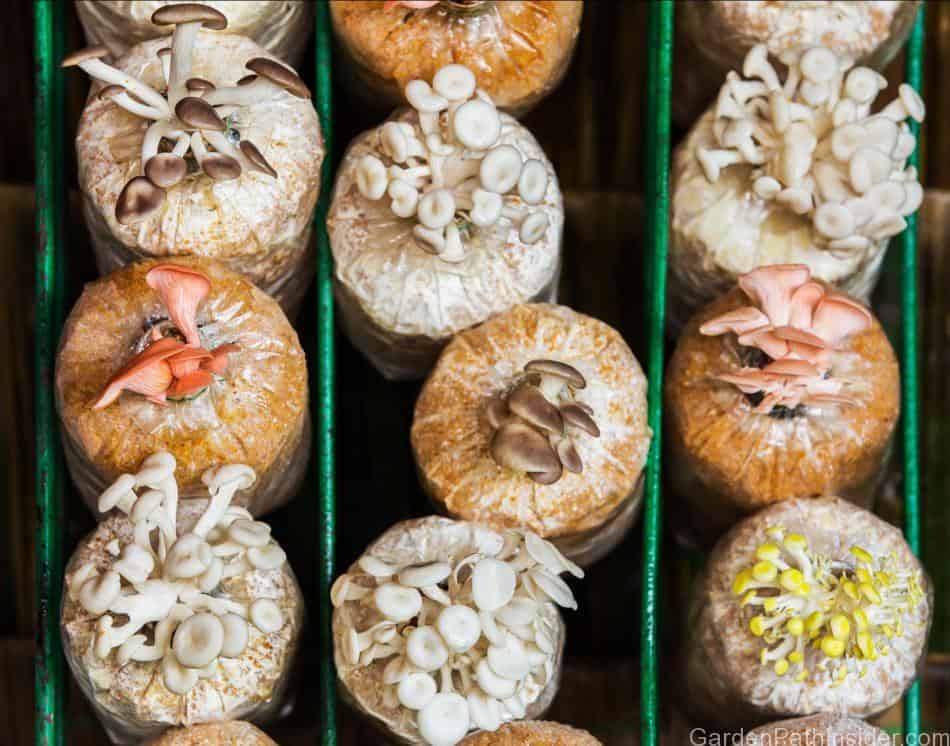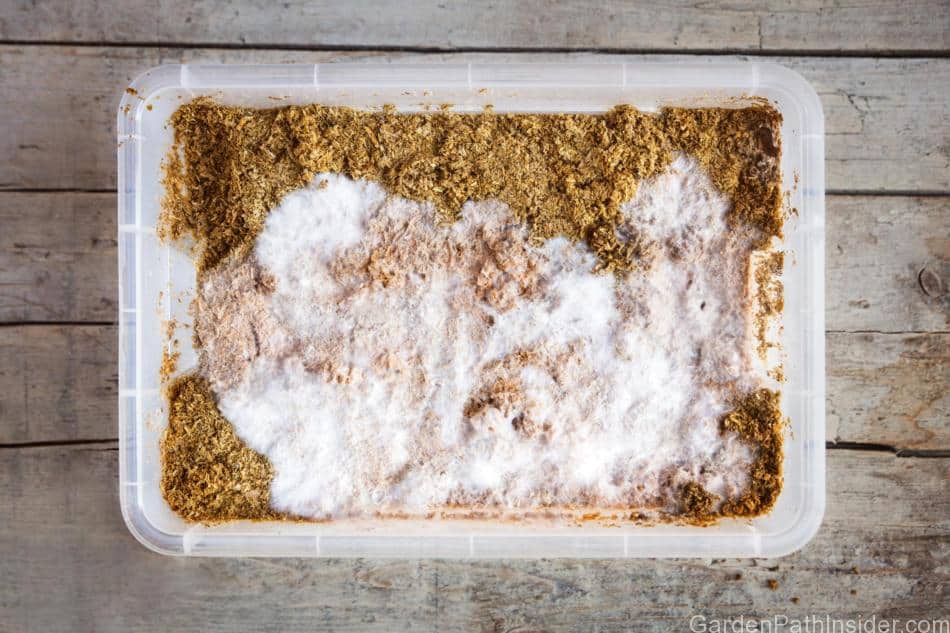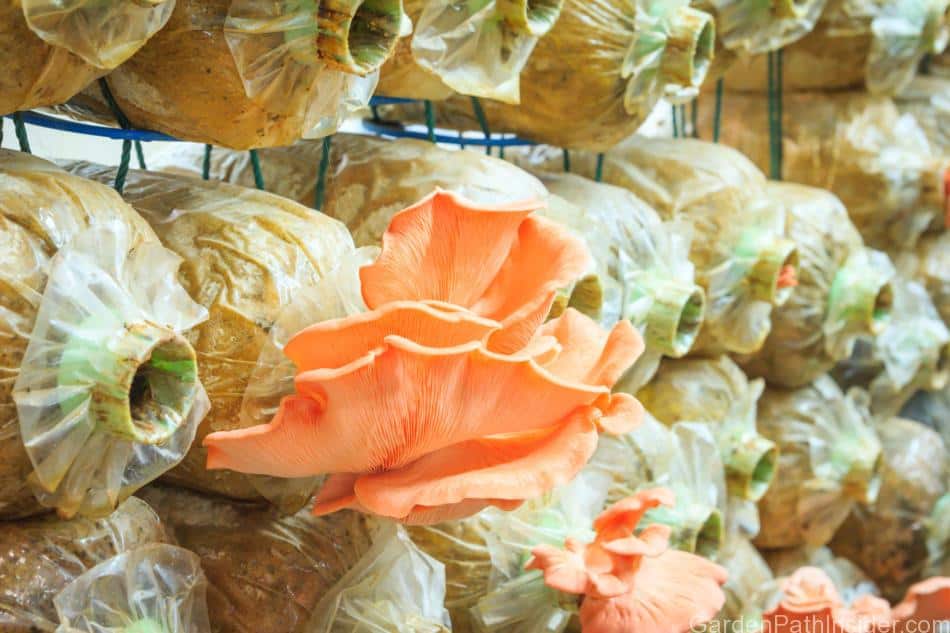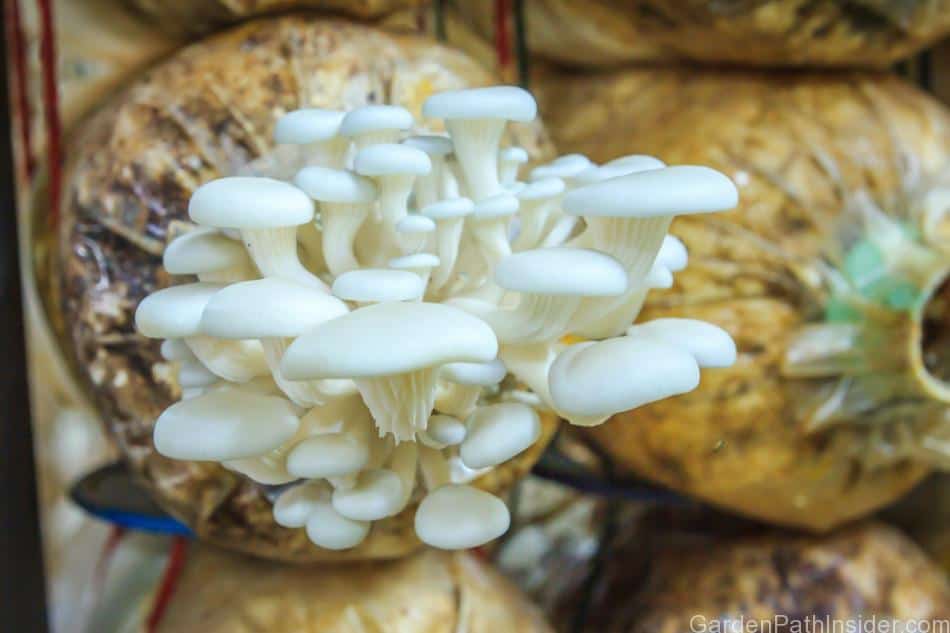
Foraging and growing mushrooms have become very popular as more tools and resources are available online. Ecommerce platforms sell everything needed to start your own mushroom garden. Both amateurs and experts can cultivate their favorite and rare species of mushrooms at home.
Growing wild mushrooms consists of 5 main phases. Temperature and time requirements vary by species. 1. Grow or purchase mycelium culture, 2. Spawn the culture on substrates and allow the mycelium to fully colonize the substrate, 3. Induce fruiting, 4. Mushrooms grow from the substrate, 5. Harvest.
Below we detail the process to grow a variety of mushroom species. These delicious fungi are easy to grow and fun to incorporate into many culinary dishes.
There are hundreds of gourmet and edible mushroom species that grow in different climates throughout the year. The exact growing system, temperatures, and time frame for a specific species to develop fruiting mushrooms, depends on the environmental conditions and the species natural habitat.
However, there are a few common requirements all Mycelium share. The three key factors of Temperature, Humidity, and Light are critical to all species of mycelium and fruiting mushrooms.
Temperature: Most mushrooms can grow between 40°F and 90°F (4.44°C to 32.22°C) however they thrive in temperatures between 55°F and 70°F (12.78°C to 21°C). Room temperature is perfect for growing most mushrooms indoors.
Humidity is also a key factor for mushroom growth. When growing mushrooms inside, keep a spray bottle of purified water handy. Spray the mushrooms as needed throughout the day to maintain a damp (not wet) environment within the growing case. If the mushrooms are fruiting, keep the mushroom caps moist with a light spray of purified water as needed throughout the day.
Light is the third key factor in growing mushrooms. Avoid placing mushrooms or the mycelium in direct sunlight as the heat can dry out and damage the mushrooms. A grow light is not needed for most species of mushrooms. Placing the mushrooms on a shelf or table that gets indirect natural light throughout the day is fine.
Keep those three factors in mind, as you design your mushroom garden.
Below we cover each step and phase of the mushroom growing cycle in more detail, along with references for additional research.
Related article: Is Mushroom Hunting Profitable?
Are you interested in growing gourmet mushrooms and selling your mushrooms online? There are many online marketplaces where mushroom hunters and mushroom growers can sell their home-grown and foraged goods. In our article ‘Is Mushroom Hunting Profitable?’ we outline different online marketplaces and platforms that give mushroom growers access to a national market.
For more information read our article: Is Mushroom Hunting Profitable?
Cover image details: Mushrooms Growing in a Farm © subinpumsom/123rf.com

1. Grow Your Own Mycelium Culture or Purchase Mycelium Culture.
When two or more healthy spores connect, they begin to grow into mycelium. Mycelium is a fungi that grows by feeding on a nutritious substrate. The mycelium eventually fruits into mushrooms when the environmental conditions are right.
Step 1: Inoculate the small jar of a sterile substrate with a liquid mushroom culture or mushroom spores that have been incubated on a petri dish with agar.
To spawn the mycelium, you need a sterile substrate. The sterile substrate could be a petri dish with agar or one of the following substrates mixed with vermiculate; wheat flour, oat flour, rye grains, other flours, or even sawdust from oak or fruit trees.
If you use an organic substrate like flour or sawdust, start with a small jar the size of a baby food jar. This way if the batch of mycelium is contaminated you can throw it away without wasting several pounds of a sterile substrate.
Keep in mind, each variety of mushrooms may benefit from growing in a specific substrate that can provide the exact nutrients needed for that mushroom culture.
The spores could germinate in as little as a week or take up to several months. The time frame depends on the species and the environmental conditions. If you are growing indoors at room temperature, you should start to see growth within 7 to 10 days. The image above shows mycelium growing on a sterile substrate.
Keep the growing conditions sterile throughout this entire process or the mycelium will become contaminated, and you will have to start the process over.

2. Transfer Mycelium to Sterile Spawn Bags of Substrate.
Step 2: Once your mycelium has spawned in your petri dish or the small jar of organic substrate, you can transfer the mycelium to a larger spawn bag.
A spawn bag is a sterile bag that you can fill with an organic and sterile substrate like oak pellets, sawdust from fruit trees, wheat flour, rye grains, etc. Spawn bags are usually 3lb to 5lb (1.36kg to 2.26kg) and made with special materials and injection ports to allow for ideal growing conditions for the mycelium.
In the image above we see many spawn bags growing Pink Oyster Mushrooms (Pleurotus djamor). These spawn bags have ports that allow the mushrooms to grow freely once the mycelium is ready to fruit.
Step 2A: Add a chunk of your mycelium from the petri dish, or about half of the small baby food size jar to one spawn bag.
Keep everything sterile during the transfer.
Step 2B: Once the spawned mycelium is in the spawn bag securely seal up the spawn bag. Then place in a cool area that gets indirect light for 5 to 10 hours each day.
Step 2C: Keep the spawn bag in temperatures between 55°F and 70°F (12°C to 21°C).
Next watch as the mycelium spreads through the spawn bag over several weeks.
Step 2D: Let the mycelium grow through the spawn bag until the mycelium has consumed and covered all of the organic matter in the bag.
The mycelium will be ready to move onto the next phase once it has grown throughout the bag and the spawn bag feels firm to the touch, signifying the mycelium has made its way to the center of the bag.
Grow kits that are sold online are usually sold in spawn bags that are several inches long and shaped like logs. The spawn bags are filled with sawdust, oak pellets, or another organic substrate. The grow kits are usually ready to produce mushrooms when they arrive at your home. Keep this in mind if you are looking for a fun and easy way to break into this hobby.
Once the mycelium has taken over the spawn bag it is time to begin to induce fruiting, also known as pinning.
3. Induce Pinning of the Mycelium to Stimulate Mushroom Growth.
When the mycelium begins to fruit it is commonly known as pinning. This is the act of the mushrooms beginning to grow.
Step 3: If you have spawned your mycelium in a spawn bag, then you can make a few small incisions in the spawn bag to allow the mycelium to break out and develop mushrooms.
Some growers use 5-gallon buckets with pre-drilled holes to grow mushrooms like Oysters and Lions Mane. Before the process is started the growers will grow the mycelium in a spawn bag and then transfer the spawn bag to the larger 5-gallon bucket and mix in more organic substrate.
The holes in the bucket allow the mycelium to fruit out on its own when it’s ready.
The fruiting process is very fun to watch as the mushroom clusters can grow noticeably larger from day to day. You may even see large clusters develop in under a week.
Related article: Is Mushroom Hunting Profitable?
Are you interested in growing gourmet mushrooms and selling your mushrooms online? There are many online marketplaces where mushroom hunters and mushroom growers can sell their home-grown and foraged goods. In our article ‘Is Mushroom Hunting Profitable?’ we outline different online marketplaces and platforms that give mushroom growers access to a national market.
For more information read our article: Is Mushroom Hunting Profitable?
4. Keep the Mushrooms Damp as They Grow From the Substrate.
As the mushrooms begin to grow out it is important to keep the mushrooms moist but not wet. Also, keep the mushrooms out of direct sunlight as the sun could dry out the mushrooms and kill the full cluster.
Wait for each mushroom cluster to develop fully before cutting off the cluster from the growing medium.
The clusters are ready to cut once the caps begin to spread.
Do not wait too long after the caps have spread as the mushrooms will then begin to drop their spores, and you will not be able to harvest the spores for the next growing cycle.

5. Harvest the Mushrooms Once the Caps Spread Open Fully.
Step 5: Harvest the mushrooms by cutting the stem right above the soil line.
Cut the mushrooms off the growing medium once the caps spread.
Take the freshly cut mushrooms and enjoy cooked, or dehydrate for use later.
Save the spores from your mushroom harvest, or save a few caps to clone.
Step 5A: To clone your mushrooms, take a small piece of the cap with spores and drop it into a small jar the size of a baby food jar, with a growing substrate, and begin the process again from step one.
Types of Mushroom Cultures to Begin Your Mushroom Garden
There are hundreds of culinary mushroom cultures you can choose from to begin your mushroom garden.
Mushroom cultures are available for purchase online in many different forms, from liquid concentrates to raw mushroom spores. You can also use mushroom spores from mushrooms you find during your foraging expeditions. Use caution as wild mushroom spores may be contaminated by wildlife or bacteria in the forest.
Below we outline the most popular forms of mushroom cultures sold online. Sites like Amazon, Etsy, and eBay all have thriving marketplaces of wild mushrooms, wild mushroom grow kits, and mushroom growing materials.
Related article: Is Mushroom Hunting Profitable?
Are you interested in growing gourmet mushrooms and selling your mushrooms online? There are many online marketplaces where mushroom hunters and mushroom growers can sell their home-grown and foraged goods. In our article ‘Is Mushroom Hunting Profitable?’ we outline different online marketplaces and platforms that give mushroom growers access to a national market.
For more information read our article: Is Mushroom Hunting Profitable?
Liquide Mushroom Cultures
Liquid cultures are a great way to start your mushroom garden. Liquid cultures can be purchased online in almost any species of gourmet culinary mushroom you can think of.
The liquid cultures come in syringes and can be injected directly into a petri dish or spawn bag to begin the growing process.
The liquid cultures come with directions on the growing requirements for each specific species.
Many sellers also sell the growing substrate and spawn bags.

Mushroom Spawn Plugs
Spawn plugs are wooden dowel plugs that have been inoculated with mycelium and are ready to be inserted in logs or fallen trees. The plugs are placed in logs or fallen trees and will take root and grow into the mushroom cluster determined by the cultures species they were inoculated with.
In the image above we see Shiitake mushrooms (Lentinula edodes) growing in an outdoor mushroom farm. The mushroom plugs are placed in logs, then the logs are proped up in rows and left to the elements as the spawn plugs grow into mushrooms.
Mushroom Spores
Spores sold online are the spores of specific mushroom culture and are sold in the base form to start your new mushroom garden.
Using a petri dish and agar, you can inoculate the agar with spores and allow the spores time to grow into mycelium. The mycelium will then grow through the petri dish and you can then introduce the agar and mycelium to your spawn bag to begin the spawning phase.
